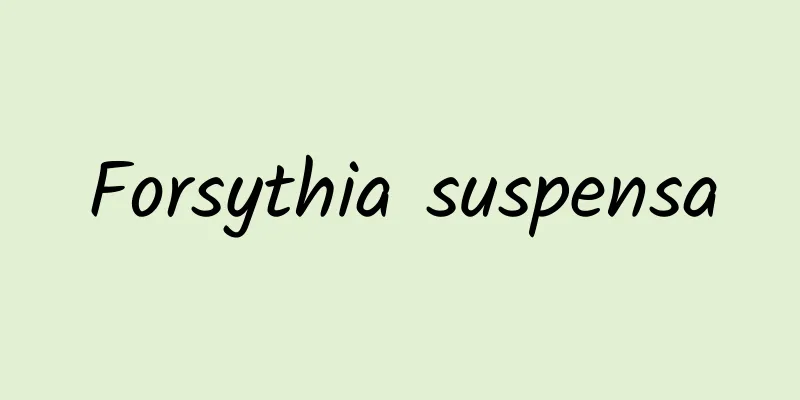A strange tree can give you unexpected effects

|
When I was in elementary school, there was an article called "The Tall Soapberry Tree". Just imagine that the soapberry tree was so big, and the soapberries on the tree had many wonderful uses, not only in daily life, but also in medicine. Later, when I went to my grandma's house to play, I saw a tree with thorns that looked like fangs bared in the air. I almost got my hand pricked by accident. When my grandma saw how embarrassed I was, she laughed and said that this was the soapberry tree mentioned in our textbooks, and there was nothing to be afraid of. At first I didn’t believe that the tree covered with strange thorns was the soapberry tree in the textbook. Later I asked my uncle who was well versed in medicine, and sure enough, this tree was the soapberry tree. My uncle said that the soapberry tree is a deciduous tree or small tree of the genus Gleditsia in the Fabaceae family, and its fruit and thorns are both medicinal materials. Gleditsia sinensis fruit is a natural raw material for medical food, health products, cosmetics and detergents; Gleditsia sinensis thorns have high economic and medicinal value. The fruits and thorns of soapberry are both very good Chinese medicinal materials, and each has its own unique effects. The effect of the fruit of soapberry is mainly on removing phlegm and initiating the orifices, especially in treating lockjaw, cough with phlegm and asthma caused by stroke; the thorns of soapberry are mainly on expelling toxins and pus, activating blood circulation and eliminating carbuncles, and are significantly effective in treating carbuncles in the early stages or those with pus that has not yet ulcerated. The fruit of soapberry not only has the function of removing phlegm and invigorating the mind, but also has good effects in many other areas. For example, to treat anorectal diseases, use one or two grams of soap beans and sophora seeds, add sticky rice bran and fry until fragrant, remove the bran and grind into fine powder, take one qian each time, and drink it with old millet soup, which can treat intestinal wind and bleeding. For example, use the soap bean, pound it, add water and rub it to extract the juice, and soak the affected area to treat rectal prolapse. The fruit of the soapberry is also a good medicine for toothache. For example, if you have toothache caused by wind-heat, you can use a stick of soap bean, add a little alum, seal it with yellow mud, put it on the fire to calcine it, grind it into fine powder after it cools down, and use the powder to rub your teeth. For example, if you have toothache caused by wind and insects, you can grind soapberry into powder and apply it on your teeth. If there is saliva in your mouth, spit out the powder. Another recipe is to use equal parts of soapberry and table salt, grind them into fine powder, and rub it on your teeth every day. The medicinal effects of the thorns of soapberry are mainly in expelling toxins and pus, promoting blood circulation and eliminating carbuncles. For example, to treat sores without heads, you can burn the thorns of soapberry into ashes, take three grams of it with rice wine, and also chew three to five sunflower seeds. The effect will be seen when the affected area feels like being pricked by a needle. For example, for the treatment of mastitis, you can use one liang of burned soapberry thorns and one qian of clam powder, grind them into fine powder, take one qian each time, and drink warm wine. For example, to treat back sores that do not break out, you can fry one or two grams of soapberry thorns with wheat bran until they turn yellow, one or two grams of dried Astragalus membranaceus, and half a liang of licorice, grind them into fine powder, take one qian each time, and drink warm wine. The use of soapberry thorns in treating sores and carbuncles is not limited to external treatments, but also involves the anus, intestines and internal organs. For example, to treat hemorrhoids and constant itching and pain around the anus, you can use 2 liang of soapberry thorn, 1 liang of clover bark, 1 liang of saposhnikovia divaricata, 1 liang of red peony root, 1 liang of Citrus aurantium, grind them into powder, use 1 jin of strong vinegar, boil half of it into a paste, and make the rest of the medicine into pills as big as red beans. Take 20 pills with the saposhnikovia divaricata decoction every time you eat. It is recorded in "Lin's Experience Prescriptions" that to treat abdominal sores in the intestines, you can use an appropriate amount of soapberry thorns and a bowl of good wine, boil them until they are seven-tenths removed, and drink them while warm. If you don't drink alcohol normally, you can also drink the decoction in water. |
<<: The medicine used to treat the prince in ancient times was so magical
Recommend
What are the effects and functions of Helicoverpa
In our lives, many Chinese medicinal herbs can he...
Appeared in Fujian 96 million years ago? The largest Deinonychus was found from footprints!
In the winter of 2020, a team from China Universi...
The principle and solution of foam formation
Foam is a common phenomenon. Generally speaking, ...
The efficacy of Chinese yam
Medicine is the best choice for treating diseases...
What are the benefits of eating Moringa seeds?
Moringa seeds are grown from the Moringa tree. Mo...
The efficacy and function of frozen green leaves
Frozen green leaves are a very good medicinal mat...
"Ugly tired" is all over the screen! I never thought that ugliness can also be considered a "work injury"
Reviewer of this article: Zhou Xiaobo, Doctor of ...
This "treasure" on the grassland really looks like the "Bull Demon King"!
On the roof of the world, the Qinghai-Tibet Plate...
How to choose safer soy sauce? What are the cognitive misunderstandings? Learn more in one article →
Recently, reports that cadmium and arsenic were d...
Ocean Science Comics | Ocean Hunter - Shark
When it comes to creatures at the top of the food...
The efficacy and function of large-leaf golden grass
Bigleaf goldenrod is a very good medicinal materi...
The efficacy and function of apricot leaf windproof
Apricot leaf fangfeng is a common Chinese medicin...
What? Not only is there no New Year's Eve this year, but even the Nian beast is gone?
Whenever the Lunar New Year approaches, the legen...
The buildings are there and the swallows are there, but they are “out of touch with reality”. Why are swifts long-term “residents” of Beijing?
Every spring and summer, agile figures can often ...









